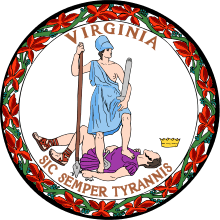Richard Bennett (Governor)
Richard Bennett (6 August 1609 – 12 April 1675) was an English Governor of the Colony of Virginia.
Biography
Born in Wiveliscombe, Somerset, Bennett served as governor from 30 April 1652, until 2 March 1655.[1][2] His uncle, Edward Bennett, was a wealthy merchant from London and one of the few Puritan members of the Virginia Company, who had travelled to Virginia Colony in 1621 and settled in Warrascoyack, renamed Isle of Wight County in 1637. Richard Bennett followed his uncle there as a representative of his business interests, and quickly rose to prominence, serving in the House of Burgesses in 1629 and 1631[3] and becoming a leader of the small Puritan community south of the James River, taking them from Warrasquyoake to Nansemond beginning in 1635. He was a member of the Governor Francis Wyatt's Council in 1639-42. In 1648, he fled to Anne Arundel, Maryland.[4]
Governor William Berkeley had been sympathetic to the Crown during the Civil War, but on 12 March 1652, he surrendered to representatives of the Commonwealth, and Bennett, then back in Virginia, was unanimously elected by the House of Burgesses on 30 April. Though little is known about his time as governor, it is believed that he was popular with the colonists.[3] While Governor of Virginia, he also spent much time directing affairs in Maryland colony, negotiating with the Susquehannock tribe and signing a treaty with them on 5 July 1652, whereby they ceded their claims to "all the land lying from the Patuxent River unto Palmer's Island on the western side of the bay of Chesapeake, and from Choptank River to the northeast branch which lies to the northward of Elk River on the eastern side of the bay." (Some of this area continued to be claimed by the Nanticoke Indian Tribe, however.) He helped ensure Puritan control over the colony of Maryland, then on 30 March 1655, voluntarily abandoned his office and left for England to see Cromwell.[5]
On 30 November 1657, Bennett, having returned to the colonies, signed the treaty with Cecilius Calvert, 2nd Baron Baltimore, which recognised the latter's claim to Maryland.[2] He returned to the governor's Council, and also became a Major-General, leading forces against a marauding Dutch fleet of four vessels committing depredations at Hampton Roads in 1667.[6]
In 1672, George Fox, founder of the Quaker movement, visited the Virginia Puritans in Nansemond and succeeded in converting most of them to his faith, including Bennett.[7]
Family
Richard Bennett is thought to be a son of Thomas Bennett (1570–1616) and Antsie Tomson of Wiveliscombe. In 1666, Secretary Thomas Ludwell wrote to Henry Bennet, 1st Earl of Arlington that Richard Bennett seemed to be of the same family, sharing the same coat of arms (also shared by the Bennetts of North Bavant, Wiltshire).[8] By 1642, Richard Bennett married Mary Ann Longworth (widow of John Utie, Jr.[9]); their children were:
- Richard Bennett Jr., married Henrietta Maria Neale, daughter of James Neale of Maryland; drowned at sea 1676
- Anna Bennett (died November 1687) first married Theodorick Bland of Westover and had three sons: the original surveyor of both Alexandria and Williamsburg Theodorick Bland, Richard Bland (who had many notable descendants), and John Bland, who was the great-grandfather of Chancellor Theodorick Bland of Maryland.[10] Her second marriage was to Col. St. Leger Codd, and they had one son, also named St. Leger Codd.[10]
- Elizabeth Bennett, married Col. Charles Scarborough of Accomac County, the son of Edmund Scarborough[11]
Bennett's descendants include Richard Bland II,[12] John Randolph of Roanoke[13] Henry Lee III,[13]Robert E. Lee,[13] and Roger Atkinson Pryor.[12]
See also
- Colony of Virginia
- Governor's Palace
- List of colonial governors of Virginia
- History of Virginia
- Bennett's Adventure
Literature
- Claus Bernet: Bennett, Richard (1609-1675), in: Biographisch-Bibliographisches Kirchenlexikon, vol. 35, Nordhausen 2014, Sp. 43-45.
References
- ↑ Lossing, Benson John (1901). Harper's Encyclopædia of United States History from 458 A.D. to 1902. Harper & Brothers. p. 544.
- 1 2 Tyler, Lyon Gardiner (1915). Encyclopedia of Virginia Biography. Lewis Historical Publishing Company. p. 47.
- 1 2 Warfield, Joshua Dorsey (1905). The Founders of Anne Arundel and Howard Counties, Maryland: A Genealogical and Biographical Review from wills, deeds and church records. Kohn & Pollock. p. 41.
- ↑ Boddie, 17th Century Isle of Wight County, Virginia p. 54
- ↑ Boddie, p. 62-73
- ↑ Boddie, p. 75
- ↑ Boddie, p. 76, 80
- ↑ Boddie, p.266-267.
- ↑ Boddie, Colonial Surrey, p. 41
- 1 2 Hunter, Joseph (1895). "Bland". In Clay, John W. Familiae Minorum Gentium II. London: The Harleian Society. pp. 421–427.
- ↑ Wise, Jennings Cropper (1911). Ye Kingdome of Accawmacke, or The Eastern Shore of Virginia in the Seventeenth Century, p. 126. Richmond: The Bell Book and Stationery Co.
- 1 2 Sons of the American Revolution (1894). "Roll of Members". Yearbook. The Republic Press. p. 198.
- 1 2 3 Boddie, John Bennett (1973). Seventeenth Century Isle of Wight County, Virginia. Genealogical Publishing Company. pp. 79–80. ISBN 0-8063-0559-2.
